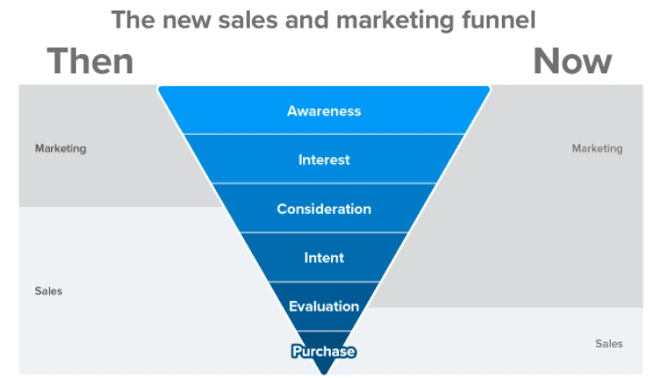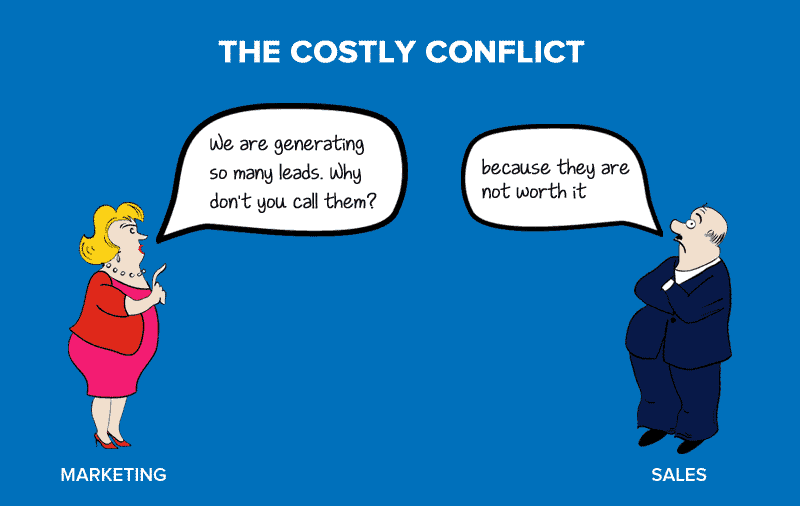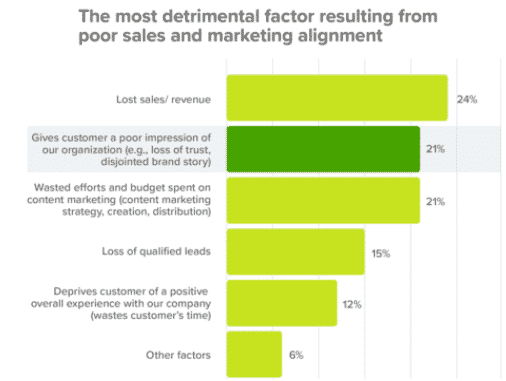67% of marketers report that trying to increase their number of leads is their number one goal, while 91% agree that marketing efforts directly contribute to increasing their revenue by 208% (Marketing Insider Group, 2019). Aligning sales and marketing can increase sales success rates by 38%. In this article, we will review the fundamental differences between sales and marketing and some effective strategies for making them work together.
Sommaire
#1 Marketing & Sales: the evolution of a relationship that has always been complicated
Not so long ago, companies relied solely on the “ABC” (Always Be Closing) approach to sales. Sales people were supposed to continually research prospects and offer products to these people in order to close a sale.
Nowadays, sales are an essential part of a broader marketing mix at the expense of old, highly inefficient techniques. Another point: most sales today are made online because instead of receiving cold calls, customers prefer to do their own research.
Buyers rely on social media to learn more about a brand to make informed buying decisions. For all these reasons, marketing is much more influential & important today in your sales cycles.

Result: a cold war between Marketing and Sales
In order to find realistic solutions, we must first look at the root of the problem. The main reasons for this dislike are ultimately overlapping objectives that are no longer so clearly separated between the marketing and sales departments. On top of that, marketers have no idea about the daily life of sales people, and vice versa.

The marketing team’s superiority complex and the sales department’s pride simply lead to a misunderstanding of the importance of the other. For example, many marketing experts believe that sales professionals have a myopic view of the business, while sales people generally underestimate the value of marketing campaigns.
#2 The benefits of good collaboration between marketing and sales
Understanding the buyer better
Marketing and sales interact with actual and potential buyers, but they do it differently, and that is why they have a different understanding of customers and their needs. If the two start working together as a team and combine their knowledge, it will become easier to create accurate customer profiles (or buyer personas).
Delivering a better customer experience
Moreover, during the buying process, a customer interacts with both sales and marketing. Ambiguous or conflicting messages can have a negative impact on the customer experience. But when both departments are aligned, prospects can be converted into satisfied customers.
Better prioritisation of prospects
Working together means benefiting from each other’s experience and knowledge. Sales and marketing teams gather a lot of information about prospects directly and indirectly. When the two teams work closely together, there is a good chance that they have shared customer data.
Both teams can position themselves to better recognise and engage the most profitable customers by sharing information about their behaviours, tastes, preferences, opinions, attitudes and pain. The more information is shared, the more salespeople can prioritise leads. Salespeople will process the best leads, and salespeople will optimise their campaigns to increase the average quality of leads.
Obtaining more resources

It is only natural for business leaders to offer support to their staff who show enthusiasm and commitment to work better together. This support will not be limited to this scenario alone, but will be extended to all aspects of the business.
From taking new initiatives to break down barriers between departments, to changing compensation plans, from allocating funds to integrating new tools, the right leaders will help teams every step of the way.
Better targeting
Today, more and more companies have become aware of the need to become strategic in their actions. Managers tend to insist on getting the big picture. In other words, they focus on long-term value.
How do marketers generate a certain type of lead without input from the sales team? Agreement on a single strategy allows both sales and marketing to work towards a common goal. Although the objectives are different for both.
Building stronger relationships

When marketing and sales work and think together, the company will be able to amplify the impact of its efforts and successfully build strong relationships with actual and potential customers. Not only that, but better cross-departmental relationships also increase employee engagement.
Building a competitive advantage
Typically, marketing professionals are responsible for assessing the market situation and analysing what competitors are doing, from changes on their websites to content on social networks. They do this to find out where they stand in their market.
A good marketing/sales alignment allows your sales team to stay on top of the competition. By knowing these details, the sales team will be much more convincing when talking to your prospects.
#3 How to better align sales and marketing teams?
Salesdorado’s advice
We recommend you read this article which presents very concrete ways for a better alignment between sales and marketing with a pragmatic approach. In the rest of this article, we will present you with some tips for better alignment.
Align the objectives of both teams
The alignment of sales and marketing allows both to understand the mission of the other. This means that sales would be able to define their expectations of marketing and articulate them clearly.
Similarly, marketing would know what kind of results sales are looking for. Knowing each other is the basis for a strong bond. For example, if you find that potential customers are not responding to a campaign, your sales and marketing teams can adjust the campaign to make it more personalised.
Encourage transparent communication

Would you believe it if I said you could sell more by communicating better? Most business leaders believe that the key factor behind the poor relationship between sales and marketing is poor communication. Open and frequent communication is one of the key elements of successful businesses.
This not only increases transparency, but also trust between these two departments, which is very important for successful collaborative efforts. But you need to adopt concrete ways to improve communication between these two departments. For example, plan regular meetings, hear both sides of the story and encourage team members to sit down together and find solutions.
Centralise information sharing
While it’s important to create an accurate buyer persona that can be used by both sales and marketing, it’s equally important to ensure that both are using a single source of information. Yes, you heard me right. To deliver a better customer experience, you need to gain a holistic view of customers.
Many customers receive phone calls for a product they have already purchased. These companies clearly need a single customer repository. Repeatedly receiving calls would frustrate anyone. This inconsistency can be eliminated by ensuring that sales and marketing get information from a single source.
Get everyone to agree on the message
We’ve all experienced it – sales and marketing call the same product by different names. The mismatch in messages loses customers and there is a good chance they will not trust the brand when they are ready to buy. In addition, you give a bad impression of your company.

This means that the representation, tone and voice of the brand must convey the same idea. Stick to one message, whether it’s the name of the product, the terms you use to differentiate your product or the brand story.
Create cross-functional projects to force collaboration
There is no doubt that each department needs to design and monitor its own indicators, but sharing KPIs is more important than ever. Why is this so? Because a culture of “succeeding or failing together” is the basis of a successful and healthy organisation.
To become customer-centric, companies need to identify and integrate measures that track both sales and marketing performance. For sales, it is easier to define and track metrics such as sales percentage, number of new leads, gross margin per customer and number of closed transactions.
But for marketers, the metrics are changing to accurately predict hot products or discover profitable market segments. Don’t forget to add digital marketing KPIs such as email subscribers, conversion rates, social media shares, etc. The important thing is to have or create KPIs that are shared between the two teams, in order to have the most customer-oriented view possible.
#4 Some examples of shared Key Performance Indicators

Commercial conversion rate
This rate measures the effectiveness of sales people. You can tell to what extent they are able to close a deal or not. This means that we are evaluating the efforts of the sales people here.
Average revenue per new customer
It is very likely that your company will get leads of very different value if you focus onmarketing/sales alignment. Calculating the conversion rate is not enough at this stage. You need to calculate the average revenue generated by a single account.
The conversion rate and average revenue per customer help determine marketing’s operational metrics, i.e. cost per lead as well as customer acquisition cost, and thus enable marketing to optimise campaigns in the right direction.
The sales cycle
The time taken to complete a sales cycle has important consequences for an organisation. In particular, it determines the effectiveness of the sales effort. The shorter the buying cycle, the better your sales and marketing teams perform. It also means that marketers are transferring the best leads to the sales department.






